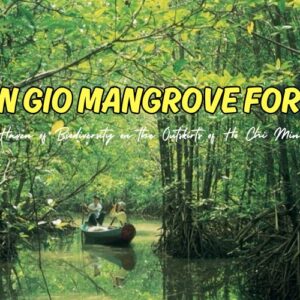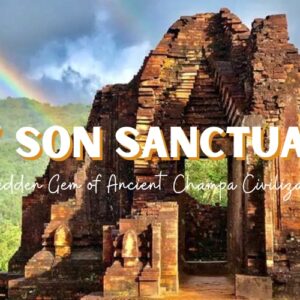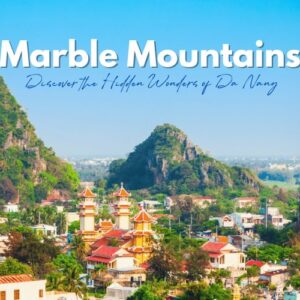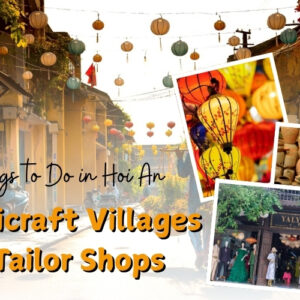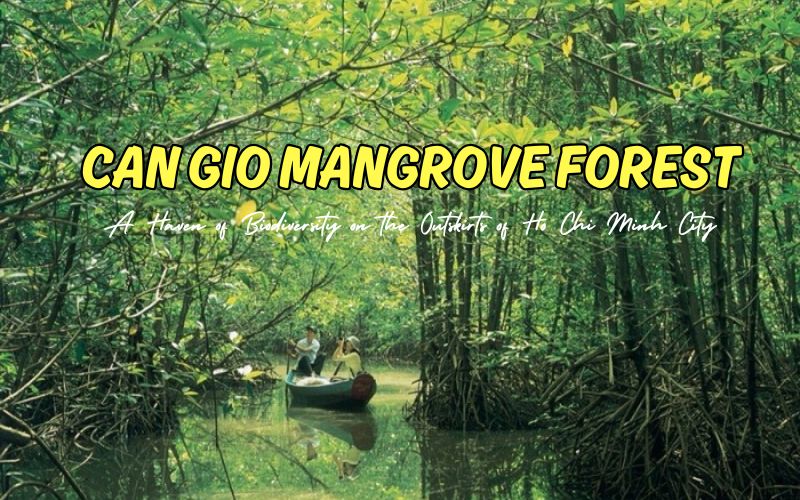
Imagine yourself padding through a mesmerizing labyrinth of emerald green. Sunlight filters through the dense canopy, casting dapple shadows on the water. Monkeys swing through the street, and exotic birds sing a vibrant chorus. This is the reality that awaits you in the Can Gio Mangrove Forest. Just a short escape from the bustling Ho Chi Minh City, this unique ecosystem offers an unforgettable adventure for those seeking a connection with nature.
Practical Information for Tourists
Entrance fees
- Entrance fee: 35,000 VND/person (~1.45 USD)
- The price for a canoe trip (round trip) to Sác Forest Base: 600,000 VND/person, or about 24.83 USD
- How to get to Can Gio Mangrove Forest?
Can Gio Mangrove Forest is located about 50 km from Ho Chi Minh City’s center, meaning that a drive will only take a little over 2 hours. Here are two transportation options you can consider:
Bus: You can take the bus to Nha Be and get off at the Binh Khanh ferry. After crossing the river by ferry, you must take another bus to get to Can Gio. Note that this bus does not stop at any fixed stations, so tell the driver or his assistant where you want to get off.
Personal vehicle: If you prefer to have more freedom in your travels, using a motorcycle or car might be a good idea. The route to Rừng Sác is quite simple to follow: head to Nguyễn Văn Linh highway, continue on Huỳnh Tấn Phát road, and finally, take the ferry from Bình Khánh to reach your destination.
Can Gio Mangrove Forest Regulations
Can Gio Mangrove Forest is not only a tourist attraction but also a world biosphere reserve recognized by UNESCO. To protect and protect local wildlife, please observe the following provisions:
- Avoid littering and damaging branches in the forest.
- Don’t feed animals with unfamiliar food, and don’t hurt them.
- Maintain respect and avoid posing inappropriately in front of historical sites.
- Pay close attention to your belongings to prevent monkeys from “robbing”.
- Wear sports shoes and moderately comfortable clothes to facilitate travel.
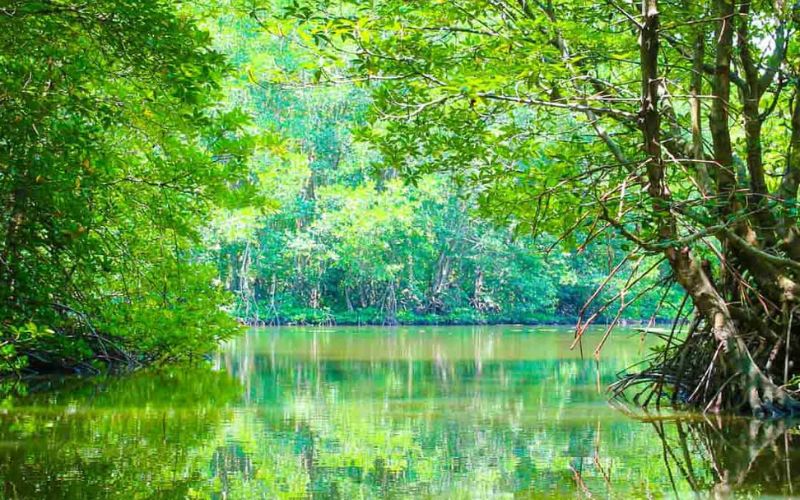
The magnificent scene of Can Gio Mangrove Forest
Overview of Can Gio Mangrove Forest
Geography and population
Can Gio Mangrove Forest Biosphere Reserve is located in the downstream part of the Dong Nai – Saigon river system, east-southeast of Ho Chi Minh City.
Total area: 70,445.34 ha.
Population: More than 75,000 inhabitants with a density of 108 residents per square kilometer. Most residents live in the transition zone, while there are only a few forest ranger families in the central and buffer zones.
Functions of the different zones
The protected area includes the entire Can Gio protected forest and the remaining administrative areas of the Can Gio district. It is divided into three regions:
Core zone (6,134.43 hectares): dedicated to the protection of forests, crops, and natural mangrove ecosystems. It also protects the landscape of the reserve and the habitat of wild animals, especially the natural regeneration of animals and plants. This area is more devoted to scientific research and limited eco-tourism.
Buffer zone (29,152.10 hectares of forest and 12,763,56 hectares of water): It aims to restore the community-based ecosystem, protect the central area, provide additional space for wildlife outside the central area, create a natural and cultural landscape for eco-tourism, and promote the eco-friendly model of forest and fisheries.
Transitional zone (13,277.79 hectares of forest and 7,267.47 hectares of water): It includes other parts of the Can Gio district. The region encourages the participation of economic models, managers, enterprises, and non-governmental, religious, cultural, scientific, and educational organizations.
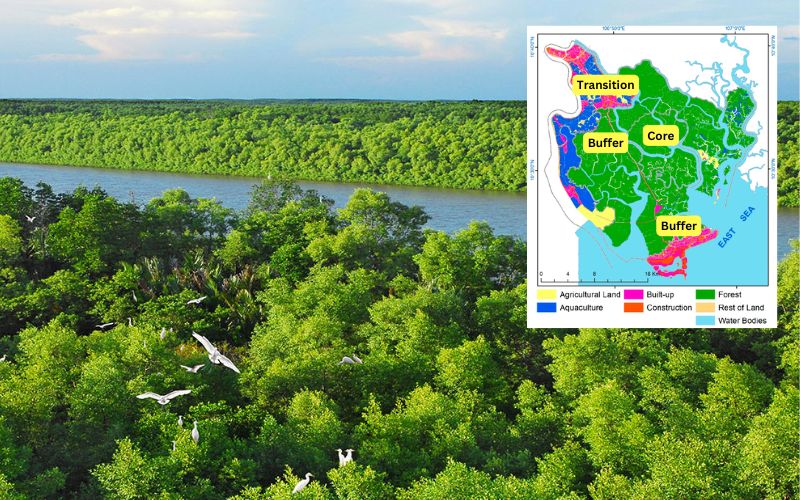
Different Zones of Can Gio Mangrove Forest
Biological diversity
Compilation and updating information on biodiversity in Can Gio Mangrove Biosphere Reserve:
Flora:
- 318 species of vascular plants:
- Main group of mangrove trees: 37 species
- Group of trees associated with mangroves: 56 species
- Group of introduced trees: 225 species
Fauna:
- Insects: 89 species
- Fish: 282 species
- Amphibians: 36 species
- Reptiles: 36 species
- Birds: 164 species
- Mammals: 35 species
- Planktonic organisms:
- 66 species of planktonic animals and 66 species of planktonic plants
History of Can Gio Mangrove Forest
In the past, Can Gio Mangrove Forest was an intact mangrove forest without human intervention or impact, thus preserving its natural and wild landscape with extremely rich fauna and flora. However, war, bombings, and toxic chemical agents have transformed this place into a “dead land” devoid of life.
Soon after the island district of Can Gio was transferred from Dong Nai province to the city on 28/02/1978, the Party and the Saigon city administration led the city’s forestry company (now the Department of Agriculture and Rural Development) in collaboration with the People’s Committee of the maritime district (now Can Gio district) to mobilize resources and manpower with the determination to restore the mangrove forest ecosystem.
So far, the area covered by the green forest has exceeded 31,000 hectares, including nearly 20,000 hectares of planted forest and more than 11,000 hectares reserved for natural regeneration and other types of forests. Thanks to the restoration, development, and protection efforts of the young volunteers and residents of Can Gio, this place has become “the green lung of Ho Chi Minh City”. Currently, this biosphere reserve is entrusted to local residents to take care of and manage it.
>>> Have you in love with the spectacular scenery of southern Vietnam yet? Reach out to this article for an immersive journey to southern Vietnam.
What to do in Can Gio Mangrove Forest?
Visit the Vam Sat Tourist Zone
The first thing visitors notice when arriving at Vam Sat is its rich biodiversity. The mangrove ecosystem is home to many species of birds, crustaceans, fish, and other aquatic life.
Crocodile Swamp
Unlike other crocodile farms in Vietnam, Vam Sat crocodiles are raised in a unique and natural semi-wild model, called Crocodile Swamp. In particular, Vam Sat’s 32 Siamese crocodiles (a freshwater variety in the world) are adapted to salt water.
Crocodile Hoa Ca
The Hoa Ca crocodile, also called the saltwater crocodile or estuarine crocodile, is the largest reptile on the planet today. Adult males measure between 6 and 7 meters long, with an average weight of 1,000 to 1,200 kilograms. Females are much smaller than their male counterparts, not exceeding 3 meters in length. They are excellent swimmers and ferocious animals. They have a fairly large head, with two crests extending from the eyes to the middle of the snout. The scales of the saltwater crocodile are diamond-shaped, and they can live for more than 100 years.
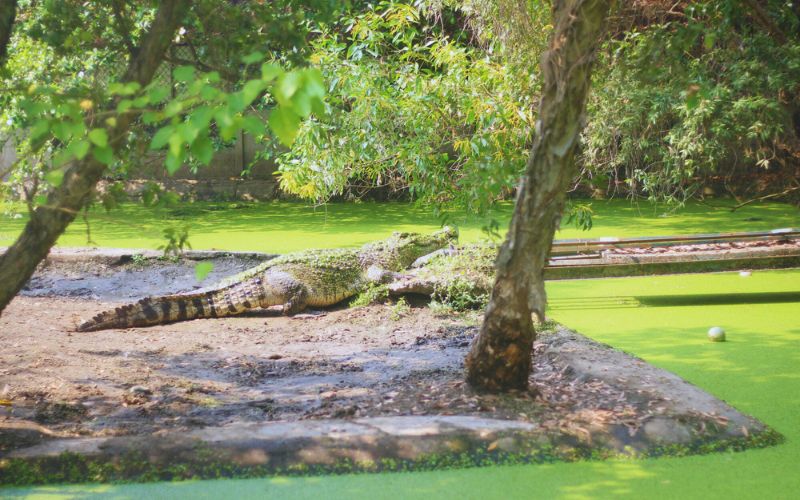
Hoa Ca Crocodile
Siamese crocodiles
The Siamese crocodile, also known as the Thai crocodile or freshwater crocodile, is a species that lives in Southeast Asian countries. The length of most wild adult insects does not exceed 3 meters. Generally speaking, pure Siamese crocodiles are harmless to humans. There are no reports of Siamese crocodiles attacking the man (except for provocation). Due to excessive hunting, this species is on the brink of extinction. It is currently listed as a critically endangered species.
Previously, in 1992, the species was considered extinct or almost extinct in the wild. Since then, some individuals (2 samples) have been found in Thailand. In Savannakhet Province (southern Laos) and Ea Lam Commune (Hinh River, Phu Yen), there are less than 100 individuals. This brings hope for the revival of this endangered species. In the Bang Siada National Park in Thailand, there is a program to reintroduce the Siamese crocodile into the wild. Some young crocodiles have been released into remote aquatic areas of the reserve, inaccessible to visitors.
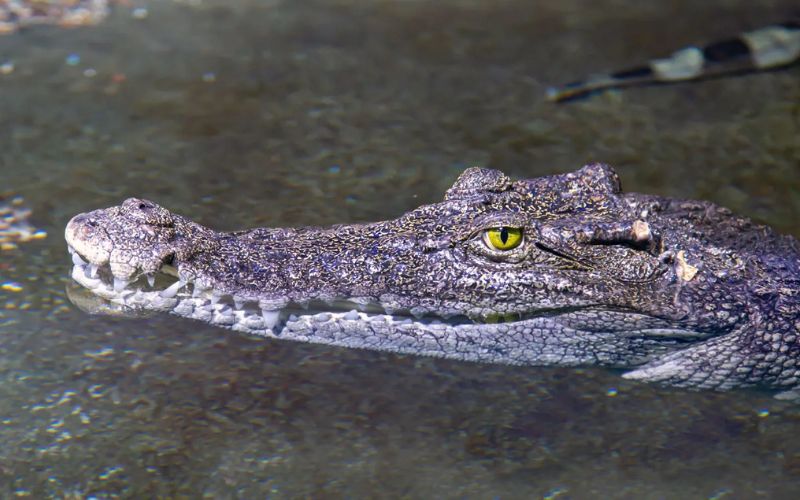
Siamese Crocodile
Crocodile fishing boat for entertainment
The crocodile swamp is only 200 meters away from the leisure center. Besides visiting, you can also experience the game “Fishing Crocodiles on the Boat”. These ships are specially designed with an iron cage protection system. The ship is driven by electricity, mounted on two buoys, and moving slowly. Each ship can carry about 7 people.
Most people are fascinated by the feeling of floating in the crocodile swamp. At this point, these saltwater predators look away from the water. They swim slowly and follow the motorcade. When waiting to catch their prey. Your task is to throw the line, which is provided by Vam Sat staff. Whenever they are eager to bite people, their sharp chins, considered as the terror of swamps, clash loudly, breaking Vam Sat’s soothing silence.
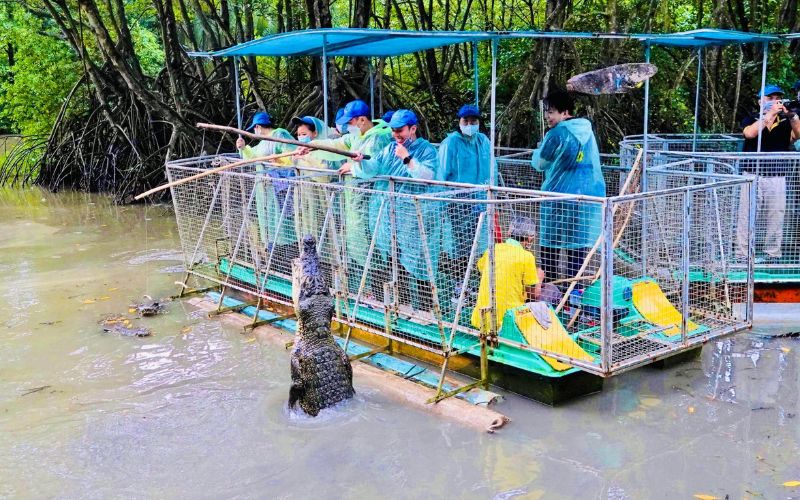
Crocodile fishing
Vam Sat Bird Reserve (Tram Chim)
Vam Sat Bird Reserve is a breeding ground for wild birds in the southern region. It is also a buffer zone for the world’s biosphere reserves. Therefore, the birds here have been perfectly protected. You can find rare birds there, such as purple herons, cormorants,
One characteristic of Vam Sat Bird Reserve is the “nesting season.” It runs from April to October every year. During this time, birds from all over come here to breed, with an estimated population of several million individuals. You will see birds flying overhead, their beaks picking up branches to build their nests. If you take an electric boat to enter the reserve, you can get closer to the bird nests.
Indian Stork (Giang Sen Bird)
This is a rare bird species listed in the Red Book, found in Vam Sat. They are also called “storm-harbinger birds.” This is a bird species from the heron family, which feeds in groups in shallow waters along rivers and lakes. They do not migrate and only move short distances within their distribution area to search for food and to breed.
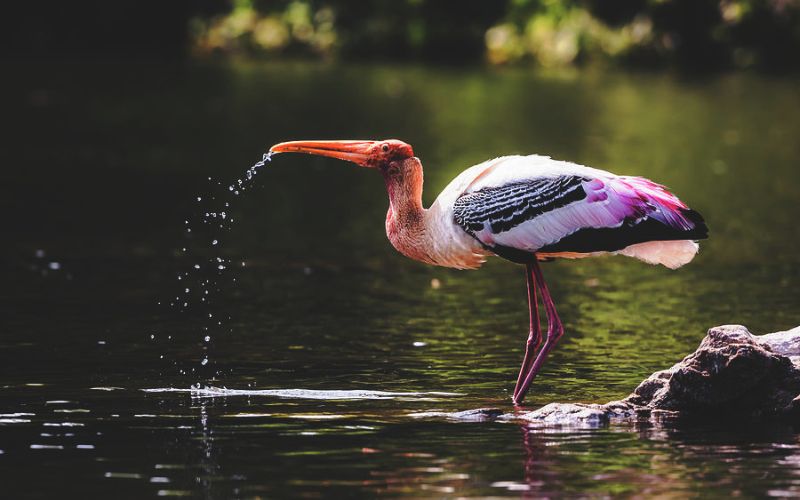
Indian Stork
>>> Craving an escape from the urban jungle? Visit our 5 Days Meking Delta Tour for more information about your nature adventure.
Hairy Marabou (Gia Day Bird)
The blad-headed Gia Day bird has plumage, and the upper part of its plumage is a uniform dark color, appearing almost all black. The head and neck are almost blad with some scattered feathers. The Gia Day mainly lives near rivers and large lakes with many trees. This species is distributed from India to the mainland of Southeast Asia to the island of Java. It is listed in the Red Book of Animal Species of Vietnam and belongs to category IB.
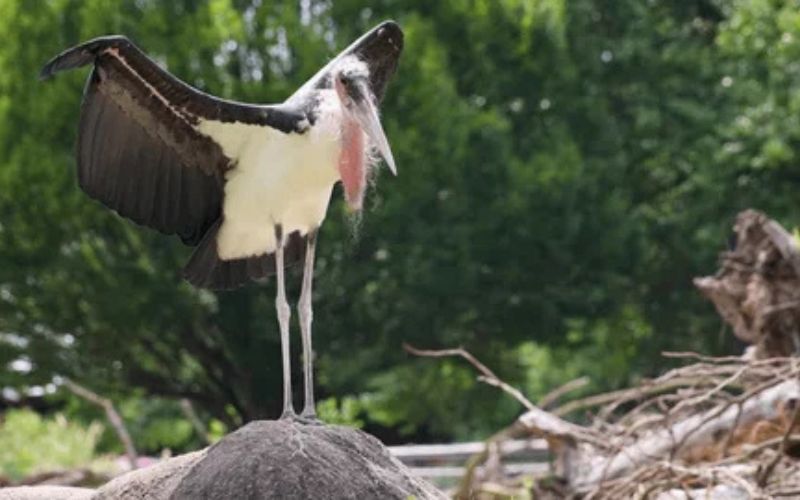
Hairy Marabou
Great Cormorant (Còng Cọc Bird)
It is an aquatic bird that usually lives in groups. However, sometimes, due to unfavorable environments such as narrow rice fields and a small number of fish, it lives alone and needs to be dispersed in search of food. This bird hunts by diving into the water and chasing its prey with superb skill. Its uniqueness lies in the fact that when it dives, its eyes are covered with a layer of white film to protect it while it still can see prey and everything around. When its neck is full of fish, the bird will climb up a tree to dry its feathers or return to its nest to feed its cubs.
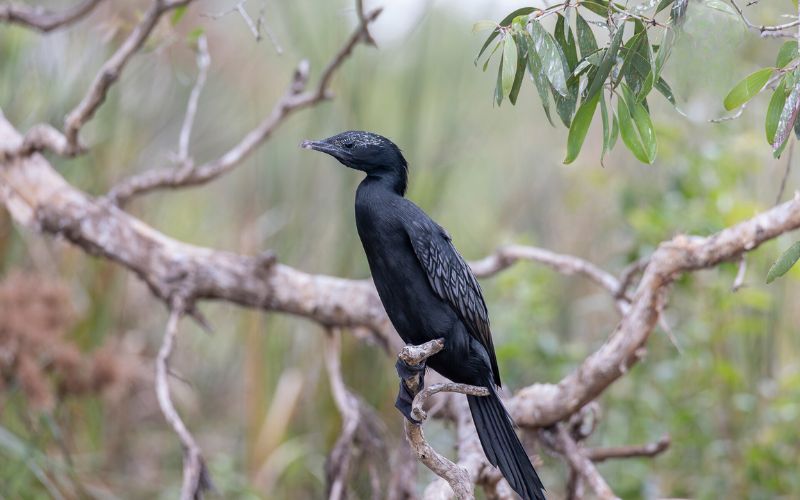
Cong Coc Bird
Heron (Diệc Bird)
It is also a predatory bird of riverine regions. In 2005, a Canadian scientist, Dr. Louis Lefebvre, announced that he had developed a method to measure the intelligence quotient of flying species based on their creativity in different hunting environments. According to his method, herons are ranked among the most intelligent birds in terms of food search.
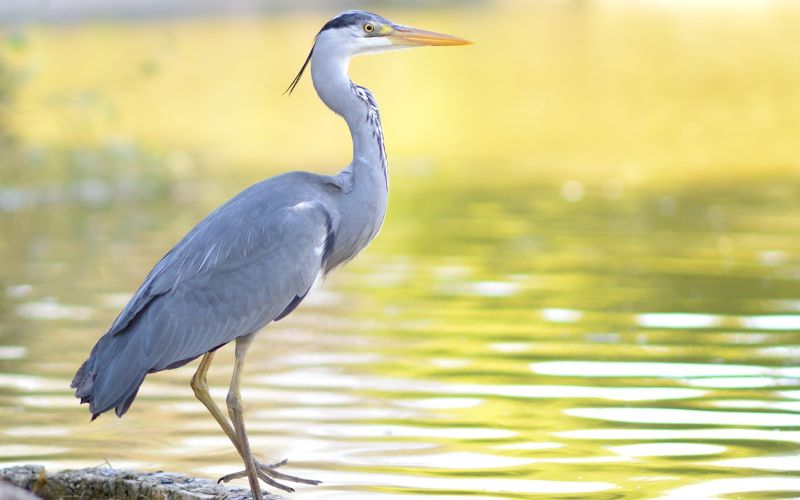
Heron
Bird watching from the lookout tower
Arriving at the entrance of Vam Sat Bird Reserve, you can walk about 200 meters inside. Along the way, you will hear the sweet singing of birds mingling with the rustling of leaves in Can Gio Forest. Then, you will come to a 25-meter-high watchtower. This tower was built by the Can Gio Forest Reserve Administration to monitor and observe bird life. You can climb up to admire the vastness of the forest and observe the vibrant bird life.
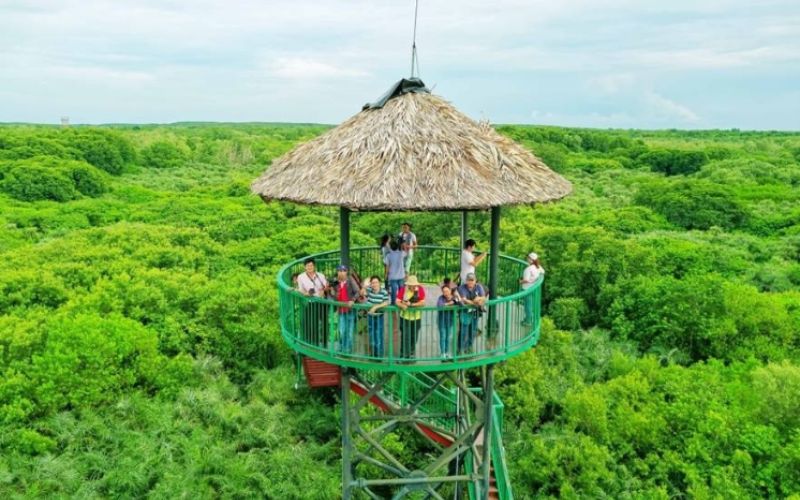
Bird-watching tower
Bird watching by electric boat
If you want to explore deeper, choose Vam Sat’s special double-shell electric boat. This ship is made of plastic composite materials and can comfortably accommodate about 7 people, traveling at low speeds. By using this mode of transportation, you can directly enter bird habitats. As you approach, hundreds of birds fly loudly on both sides of the canal. This scene will surprise and inspire you. In addition, you will see birds perched on closer tree branches. Species such as Giang Sen and Gia Day, which are listed on the World Red List, live here in large groups.
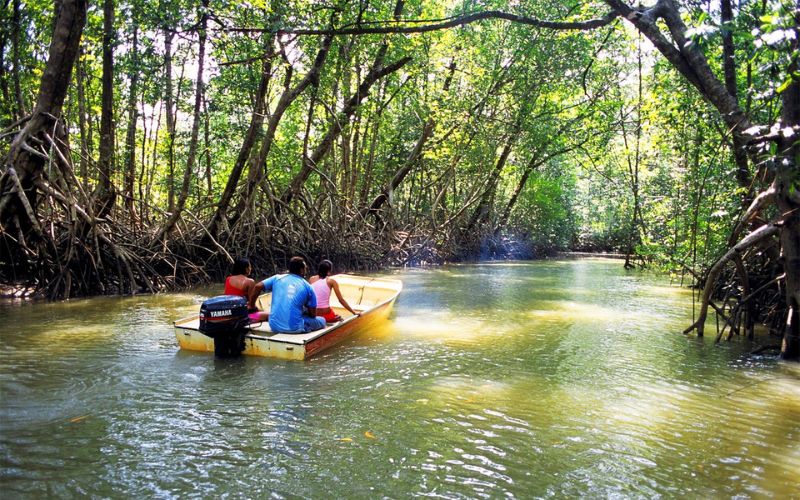
Bird watching by electric boat
Bat Swamp
Also called “Artistic Bat Reserve,” this is one of the points of interest for visitors who like to explore the wildlife in Vam Sat. What is special is that the bats are concentrated only on one small palm island in the swamp. They do not live in the adjacent palm area, even though it is only a few meters away. Several hypotheses suggest that this island could be influenced by magnetic fields, hence the high concentration of bats, or for other environmental reasons. So far, there is no definitive answer.
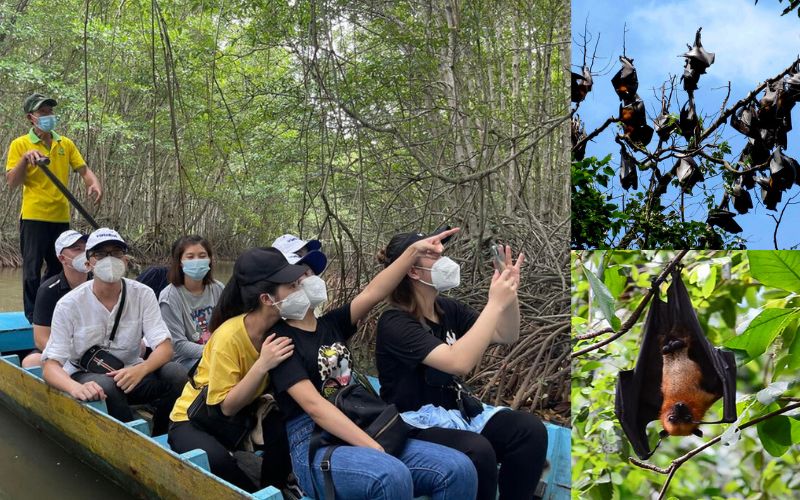
Bat Swamp
Explore the Sác Forest combat zone
The historical site of Sac Can Gio Forest Combat Zone (formerly called Can Gi Park) covers an area of 2,215.45 hectares, of which 514 hectares have been and are currently being exploited for tourism purposes. This place has all the species and ecosystems characteristic of a typical mangrove forest sub-region. It also breeds many groups of monkeys, with a total of more than 1,000 individuals, living entirely in natural conditions and very familiar with humans. The place has perfected and continues to develop various facilities such as forest accommodation, restaurants, shops selling typical mangrove products, a traditional house, an exhibition hall displaying restored objects, archaeology, etc.
Located inside the historical site of Sac Forest Combat Zone in Can Gio is Sac Forest Revolutionary Base. This place is recognized as a national historical site. This base became famous thanks to the heroic past of the Sac Forest Special Forces Team. The base has been rebuilt to fully recreate the living and fighting environment of the heroes of the past. It is a highlight that attracts the attention of many visitors.
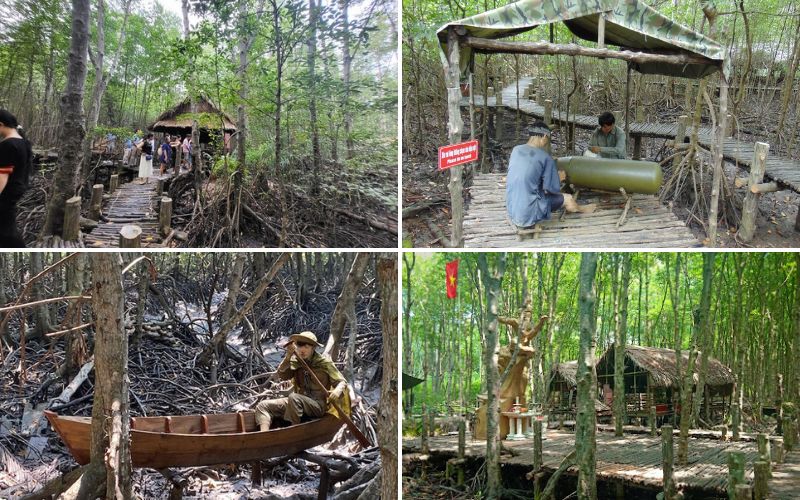
Sác Forest combat zone
Discover Monkey Island
Monkey is part of the Can Gio Biosphere Reserve, surrounded by ancient forests and waterways. It is also home to over 2,000 monkeys of various species. When you visit this place, you will have many memorable memories with your friends and family.
Coming here, you will feel the fresh air and breeze. The peaceful atmosphere of this place contrasts sharply with the fog pollution and honking of busy cities. That’s why tourists always feel comfortable and excited, immersed in nature, and appreciate the simple and rustic beauty of this place.
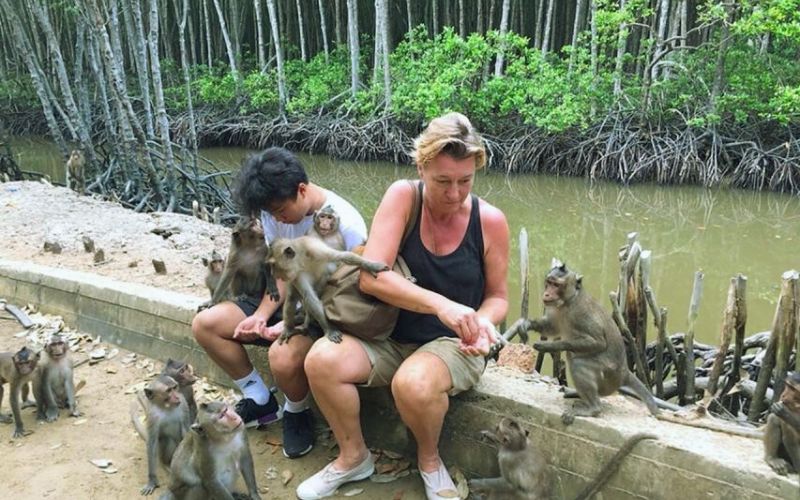
Monkey Island
Participate in the Nghinh Ông Festival
Nghinh Ong Can Gio Forest Festival is a national intangible cultural heritage recognized in 2013. Every year, around mid-August of the lunar calendar, people from various places flock to Can Thanh City to participate in the Nginh Ong Festival. An old fisherman in Can Gio recounts that: “In the late 19th century, many legends about whales took place here, such as helping sailors overcome many accidents, from saving a sinking boat to saving a person in distress drifting to look for his way to the shore to escape death. These legends have made faith and gratitude a widespread belief throughout the coastal region of Can Gio in particular and other coastal regions in general. At that time, locals erected a mausoleum after a whale in distress died and was washed up on Can Gio Beach. Later, they asked the royal court to grant a sacred ordinance for worship.
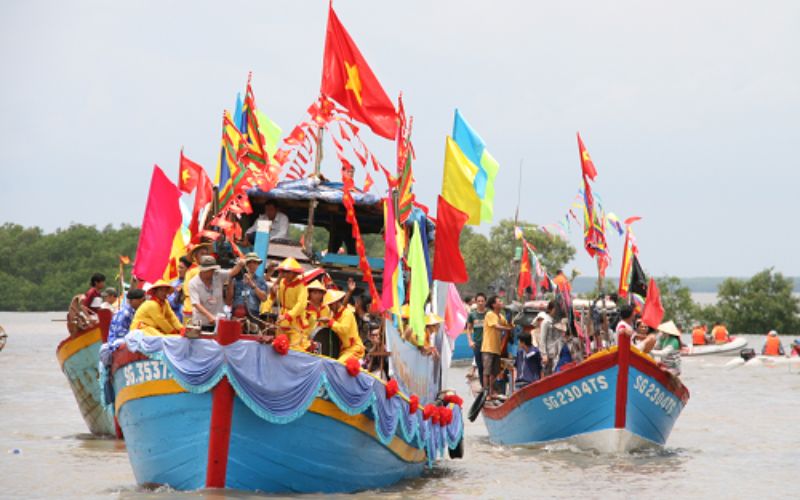
Nghinh Ông Festival
What to Eat at Can Gio Mangrove Forest?
Thoi Loi Fish Salad Mixed with Lim Kim Leaves
It is very simple and quick to prepare the Thoi Loi fish salad and mix it with Lim Kim leaves. Collect fresh lotus leaves, take out the stems, wash them carefully, and put them in the basket. The taste of salad depends on the way fish sauce is made. The leaves are slightly sour and bitter, so fish sauce should be slightly sweet.
The fish Thoi Loi is considered a creature in the swamp because, although its shape is the ugliest, it has soft, fragrant, soft meat, which is better than freshwater fish, such as broth, shark’s fin, or tuna.
After mixing the fish sauce with tomatoes in a proper proportion, pour it into the leaves of Lim Kim and mix well. Sometimes there is no need to mix because guests can taste the dishes themselves. Spit out some fried scales and some peppers, and it will be ready.
When visiting the Sac Forest Combat Zone, it’s a very pleasant experience to take a boat in the middle of the forest, sit on the board, taste every mint leaf and rice wine on the salad plate, and listen to the stories of special forces veterans who fought crocodiles and wild animals.
The slight acidity and bitterness of mint leaves, combined with the sweetness of sweet fish sauce, make you want to continue eating. In particular, this simple dish becomes more delicious when combined with Sac Forest Honey Wine.
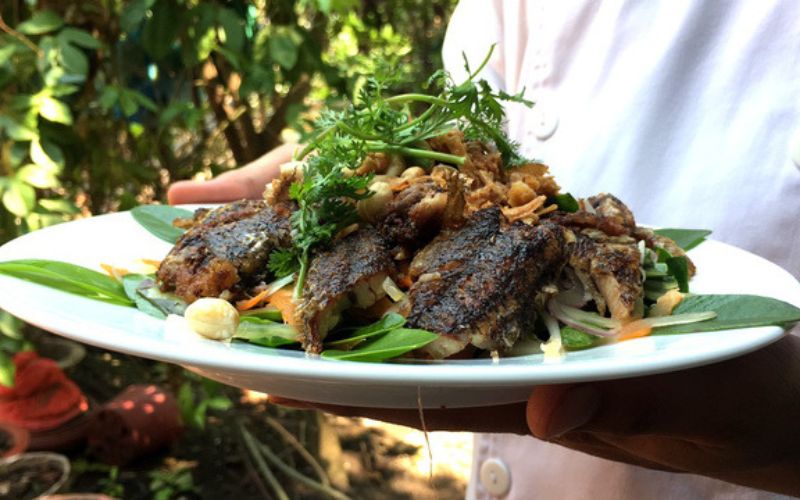
Thoi Loi Fish Salad Mixed with Lim Kim Leaves
Sweet and sour soup with Khoai fish (canh chua cá Khoai)
Another delicacy of Can Gio is hot and sour with Khoai fish (canh chua cá Khoai). This soup uses Khoai fish whose flesh is fragrant and fatty, perfectly combining with the sour ingredients to create an incredible flavor. It is a perfect dish to enjoy on hot days and is also commonly prepared for daily meals by the people of Can Gio.
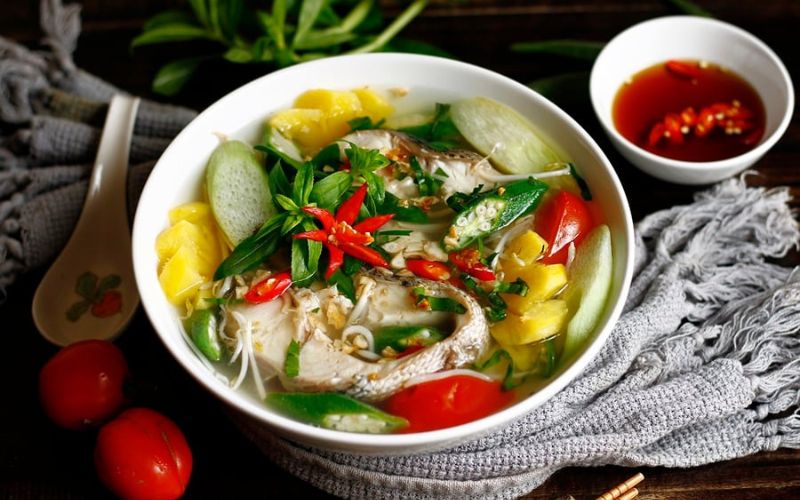
Sweet and sour soup with Khoai fish
>>> Your taste buds would definitely awaken by Vietnamese cuisne! Here are top 30 Must-try Vietnam Foods you should bear in mind.
Vam Sat Saltwater Duck
Can Gio’s specialty is truly everywhere, whether on land or underwater. Then, Vam Sat saltwater duck will seduce you. This type of duck is raised in the salt pans of Vam Sat, where it can move around comfortably, resulting in firm and tasty flesh without excess fat. The best way to enjoy Vam Sat saltwater duck is to steam it with rice. After cooking, it will present a beautiful golden color, which makes it very attractive. Its fragrance is very intoxicating, and when you chew it, you will find soft and delicious flesh. To taste this duck dish, it is important to pair it with various vegetables and a suitable sauce to achieve the perfect flavor.
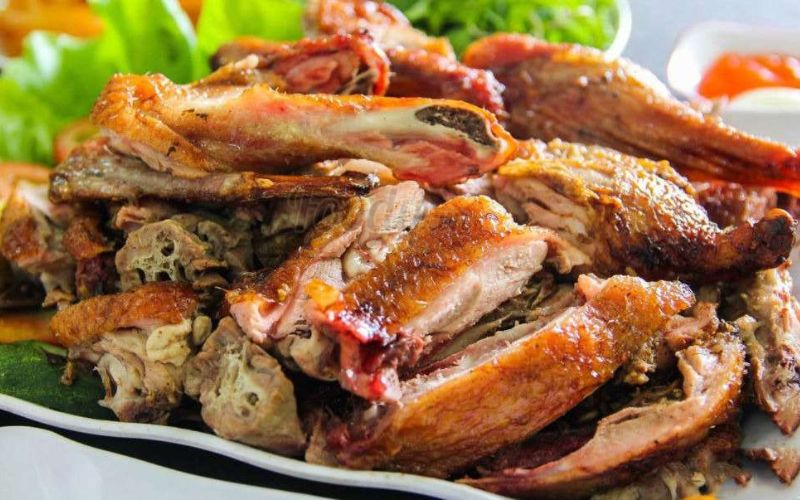
Vam Sat Saltwater Duck
Water Coconut
Water coconut is a kind of coconut that grows in Can Gio swamp and in a separate compartment. To taste it, cut the coconut in half, take out the meat from the coconut with a spoon, and then mix it with sugar and ice. Coconut meat can also be processed into sauce or used to make desserts. The benefits of coconut are undeniable because it can help detoxify, regulate body temperature, and treat hypertension. You can enjoy it with confidence.
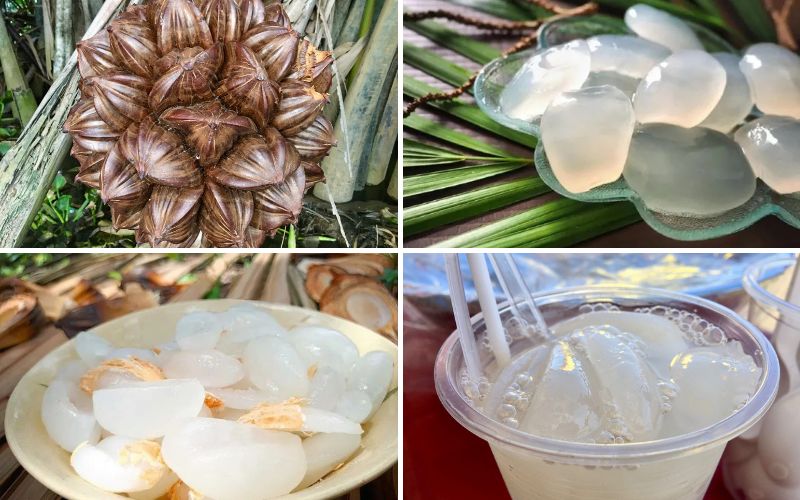
Water Coconut
The Can Gio Mangrove Forest is an exceptional ecosystem that plays a crucial role both ecologically and culturally. As a true green lung of the region, it actively contributes to climate regulation, biodiversity preservation, and protection against erosion and sea level rise. In addition, its cultural significance has reflected the traditions and celebrations of local communities, such as the Nghinh Ong Festival, a testament to the intimate relationship between man and nature. The Can Gio Mangrove Forest is not only a natural treasure for Vietnam. But also serves as a reminder of the importance of protecting and enhancing our ecosystems for future generations.
Feel free to contact us to explore the best tours in Ho Chi Minh City. Our committed experts are always ready to assist you in realizing your ideal vacation!
Read more:
